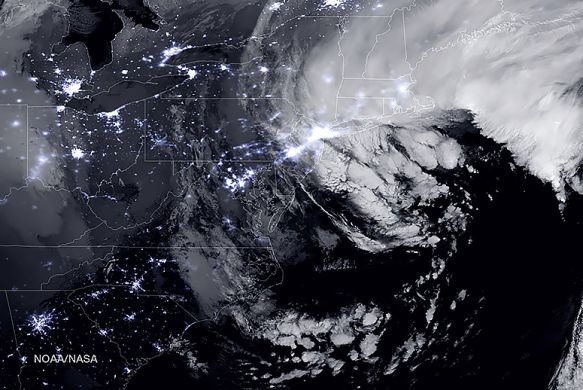Scary New Proof That We Have Seriously Screwed Up the Planet’s Oceans
TAKE PART DAILY – MERCHANTS OF DOUBT
Scientists confirm that climate change is stalling a major Atlantic Ocean current, and that could lead to flooding and food shortages.
(Image: NOAA/NASA)
Emily J. Gertz is TakePart’s associate editor for environment and wildlife.
The powerful ocean current that carries tropical warmth from the South Atlantic to northern countries has slowed down to a degree “unprecedented in the past millennium,” according to newly published research. The phenomenon has created an unusual pocket of cooling temperatures in the far North Atlantic, even as global warming heats the world overall.
Yes, it’s the exact climate catastrophe envisioned in The Day After Tomorrow, the 2004 movie about how a slowing current triggers a new ice age and deep-freezes New York City. In real life, the current could cause severe coastal flooding between New York and Boston and affect the distribution of marine wildlife, putting coastal fishing industries at risk.
If the slowdown persists or intensifies, weather could significantly change in parts of the Northern Hemisphere that have traditionally been warmed by this current, affecting everything from agriculture to urban transportation.
“These are the kinds of things that scare me,” said oceanographer Scott Rutherford of Roger Williams University in Rhode Island, who coauthored the new study. “How much is this going to change temperature, sea level, marine ecosystems? We’re starting to mess with big things now.”
“Can we stop this? Yes,” he said. “We’re already locked into a little bit of warming. I would say that we ought to be concerned with minimizing it as much as we can.”
It’s the first time scientists have analyzed trends in the “Atlantic meridional overturning circulation” over such a lengthy period, which allowed them to contrast its contemporary state to preindustrial conditions and beyond.
The slowdown is one more recent sign that burning fossil fuels, the leading cause of global warming, has fundamentally disrupted Earth’s climate.
Last week the National Snow and Ice Data Center announced that less sea ice formed in the Arctic this winter than at any other time in the 35-year satellite record. The National Oceanic and Atmospheric Administration, meanwhile, announced that globally, the winter of 2014–15 was the warmest ever—except on the East Coast of the United States and in parts of West Africa and Western Europe, all areas that that saw unusually cool or cold weather, and that depend on this current to supply them with heat.
The study, published Monday in the journal Nature Climate Change, looked at trends in the current, which flows between North and South America, transporting heat northward and cold southward. (The Gulf Stream current that many of us learned about as schoolchildren is a part of this larger circulation.)
In addition to the written record, the researchers used data that came from interpreting nature’s own records—ice and sea sediment core samples, as well as tree rings—to go far back in time.
We Might Avert Climate Catastrophe With This One Radical Choice
By deducting sea surface temperatures from averaged land and sea temperatures, they figured out what temperature the current must have been, and based on that, determined its salinity and speed.
“For about 900, nearly 1,000 years, the AMOC stays relatively stable,” said Rutherford. “It bounces around, but it’s not until about 1900 that we start to see a relatively steady decline.”
“From 1970 to 1990, we see a very rapid drop in temperature” in the current, he added, followed by a warmer period from 1990 to 2010. But “from 2010, we’re starting to see a decline again,” he said.
Both current cooldowns happened shortly after large amounts of freshwater appeared in the North Atlantic. The earlier pulse of freshwater came from a load of Arctic Ocean ice flowing into the North Atlantic; the latest came from Greenland’s glaciers, which have been melting faster since the 1990s.
Ocean Current Climate
(Infographic: Courtesy NOAA)
 Embed This
Embed This
“It really showed up this past winter in the surface temperature maps,” Rutherford said. “That very, very cold spot reappears just south of Greenland.”
Scientifically, “it’s a bit of stretch right now” to link this winter’s record low temperatures and snowfall on much of the East Coast to the slowed ocean current, he said. “But it’s the kind of thing that we might expect to see” based on climate change modeling.
“As a scientist, this is just one more data point to add to our records,” said climate scientist Katharine Hayhoe of Texas Tech University. “As a human, though, it’s a stark reminder that our choices have consequences, and the door is rapidly closing on our opportunities to choose a different future.”








Follow Us!